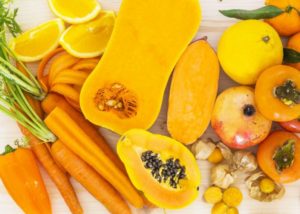Carotenoids: Another Benefit of Fruits and Vegetables

By Reed Mangels, PhD, RD
A new study of middle-aged and older women, which you will be able to read about in an upcoming issue of Vegetarian Journal, found that those with higher intakes of total and individual carotenoids had a lower risk of experiencing a decline in brain function with aging.
You may have heard of beta-carotene – a carotenoid which is used to make vitamin A. Other carotenoids include alpha-carotene, beta-cryptoxanthin, lutein + zeaxanthin, and lycopene. Although not all of these can produce vitamin A, they all offer health benefits.
Since fruits and vegetables are, by far, the main sources of carotenoids, those who eat lots of plant foods have an advantage when it comes to carotenoid intake. Based on a dinner conversation at my house, I’ve compiled a list of the top sources of individual carotenoids. Other fruits, especially deep orange ones, and vegetables, especially orange and dark green vegetables, will also add carotenoids to your diet.
Top Sources of Beta-carotene (based on a 1 cup serving)
- Sweet potatoes, cooked
- Spinach, cooked
- Carrots, raw
- Kale, cooked
- Mustard greens, cooked
- Butternut squash, cooked
- Hubbard squash, cooked
- Beet greens, cooked
- Turnip greens, cooked
- Collards, cooked
Top Sources of Alpha-carotene (based on a 1 cup serving)
- Pumpkin, cooked
- Carrots, raw
- Butternut squash, cooked
- Hubbard squash, cooked
- Plantain, green, cooked
- Tangerines, raw
- Tomatoes, raw
- Collards, cooked
- Corn, cooked
- Green peas, cooked
Top Sources of Beta-cryptoxanthin (based on a 1 cup serving unless otherwise specified)
- Butternut squash, cooked
- Japanese persimmon, raw (1 fruit)
- Papaya, raw
- Tangerines, raw
- Corn, cooked
- Oranges, raw
- Apricots, raw
- Nectarines, raw
- Watermelon, raw
- Peaches, raw
Top Sources of Lycopene (based on a 1 cup serving unless otherwise specified)
- Watermelon, raw
- Tomatoes, canned
- Tomatoes, raw
- Papaya, raw
- Grapefruit, raw
- Japanese persimmon, raw (1 fruit)
- Asparagus, cooked
Top Sources of Lutein + Zeaxanthin (based on a 1 cup serving)
- Kale, cooked
- Spinach, cooked
- Mustard greens, cooked
- Turnip greens, cooked
- Collards, cooked
- Cress, raw
- Summer squash, cooked
- Green peas, cooked
- Beet greens, cooked
- Pumpkin, cooked
Source: U.S. Department of Agriculture, Agricultural Research Service. FoodData Central, 2019. fdc.nal.usda.gov
